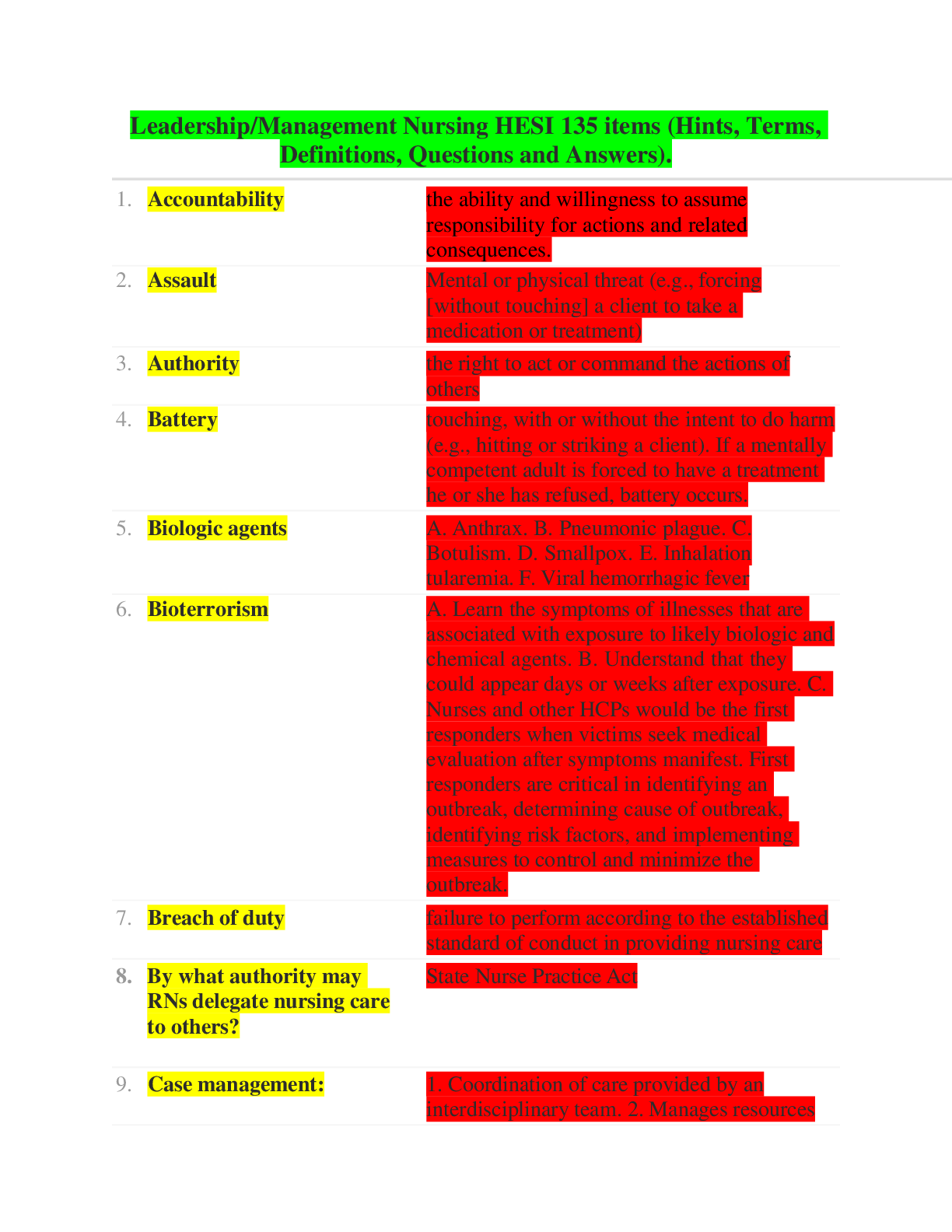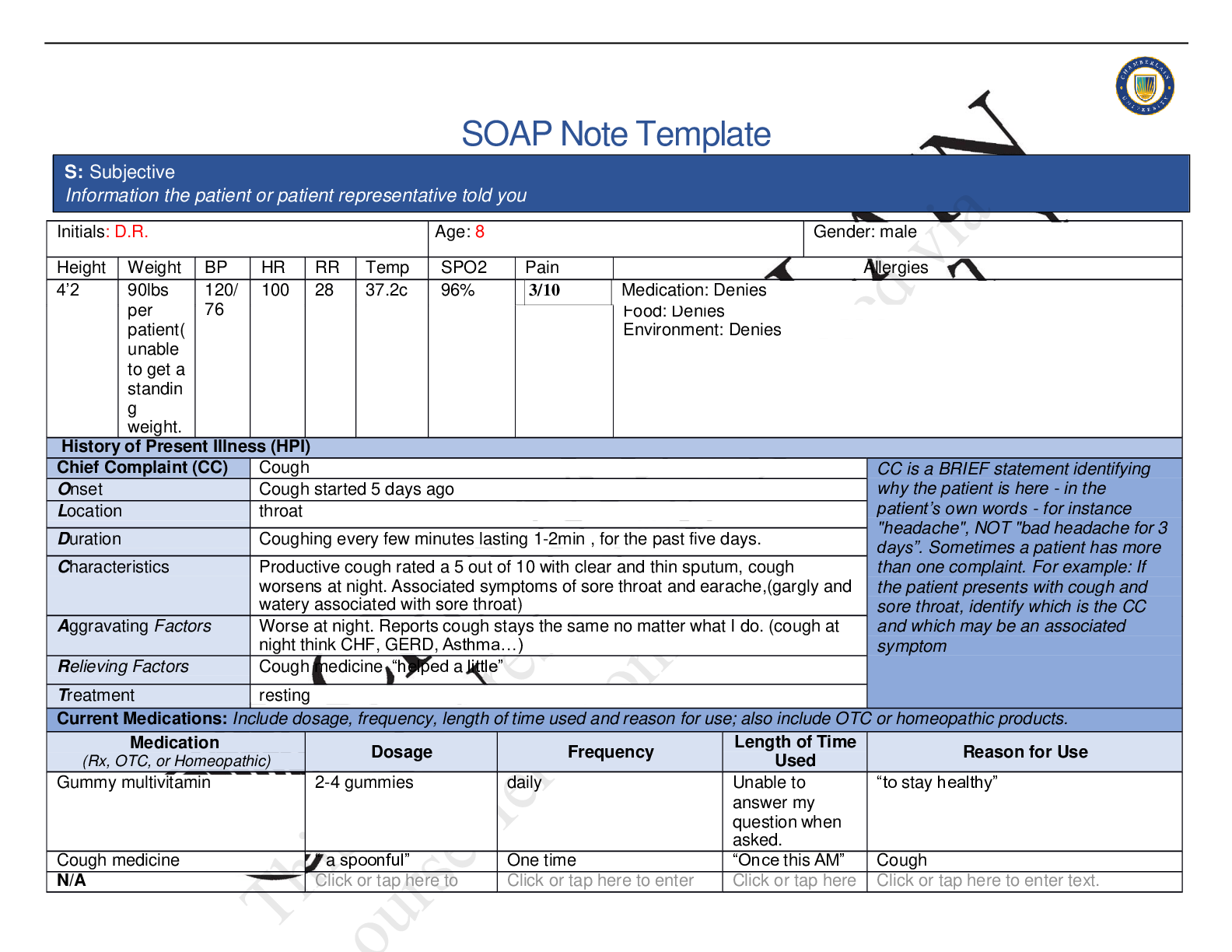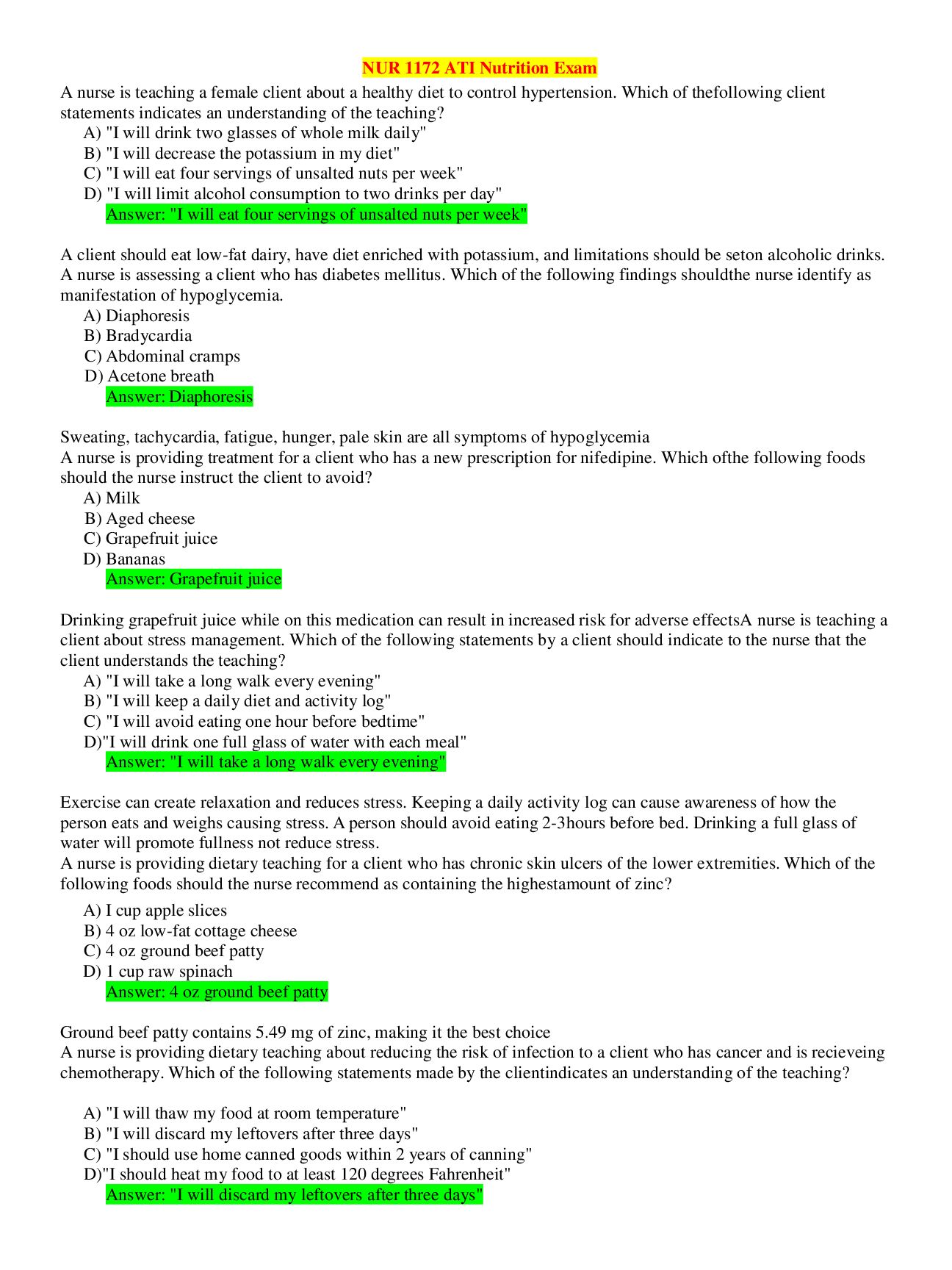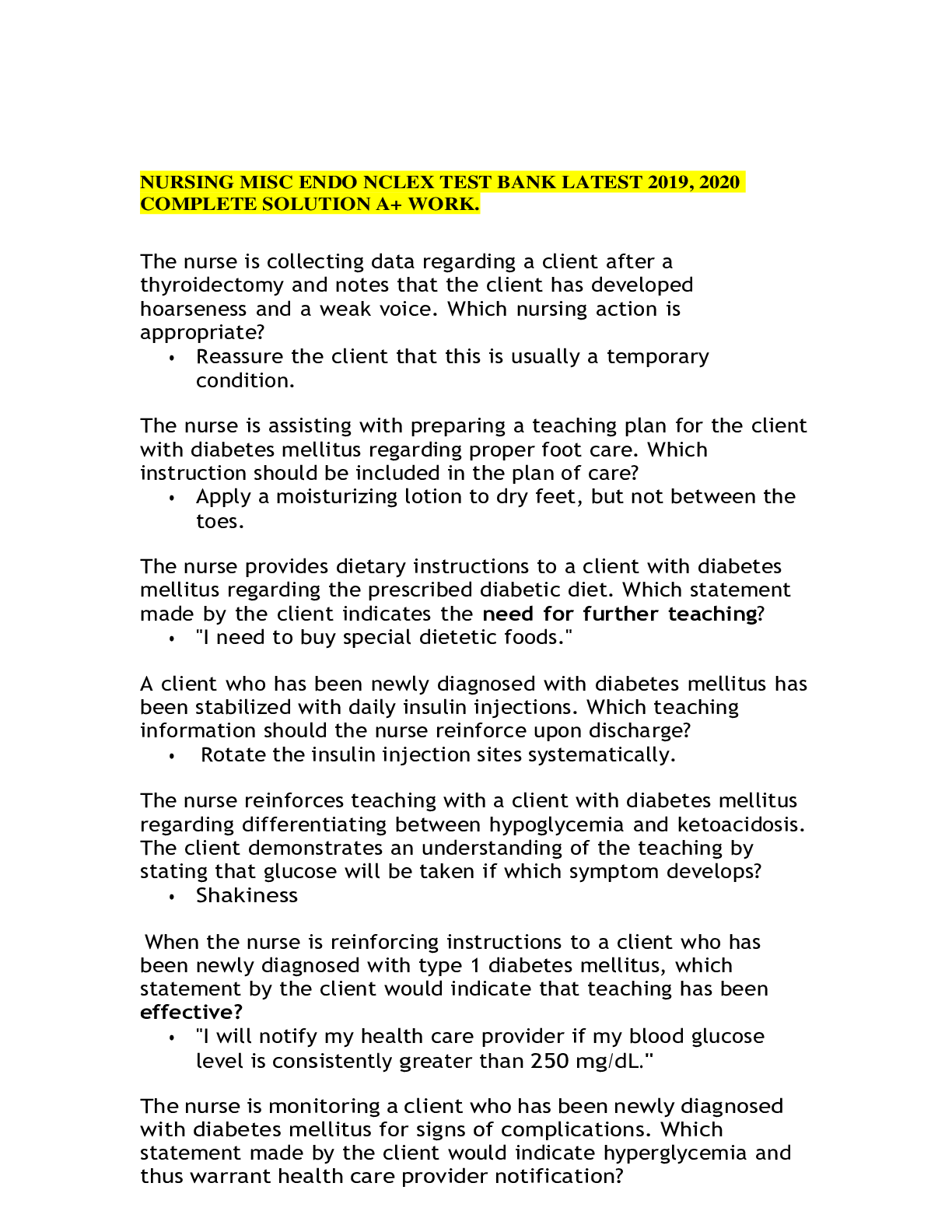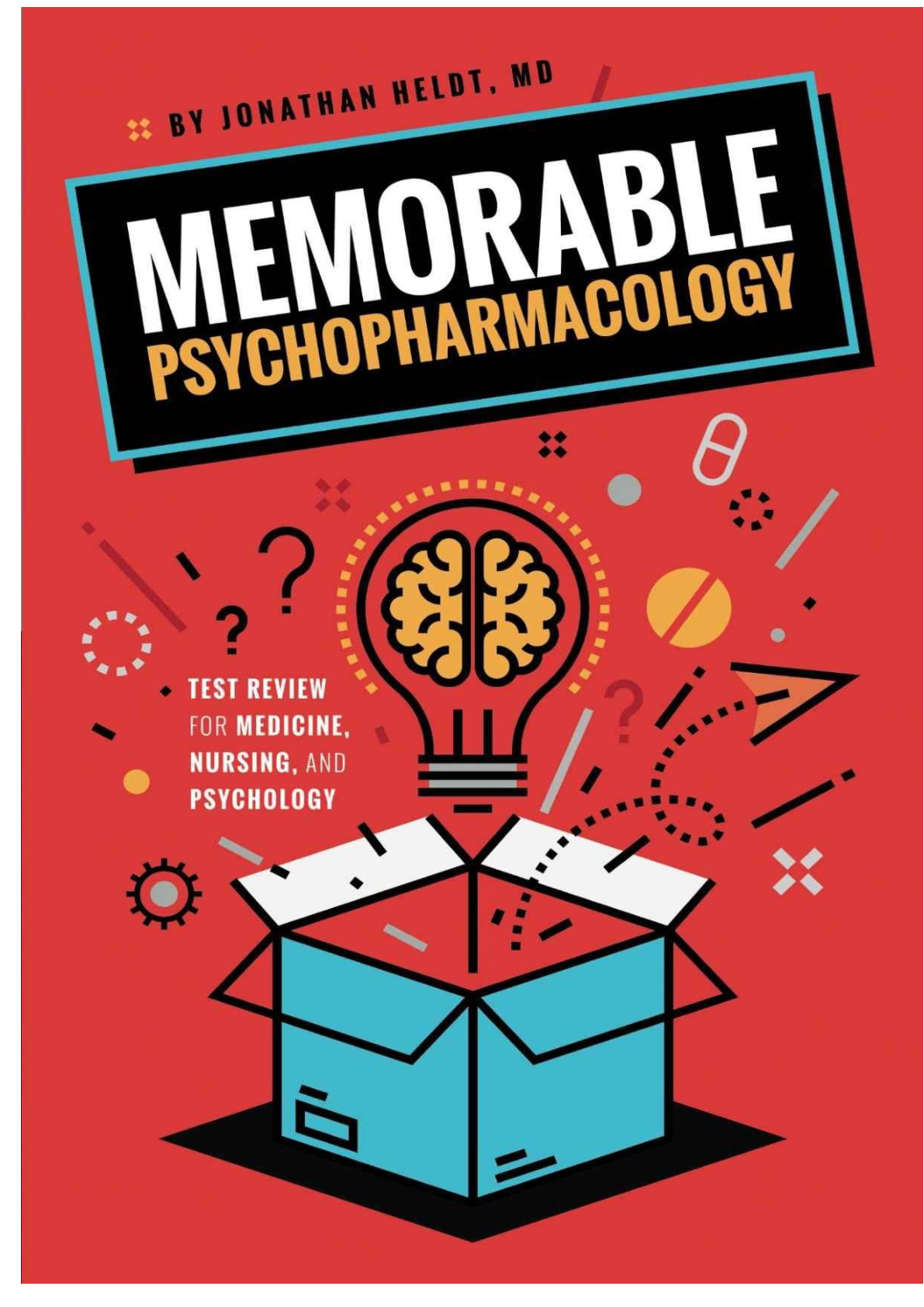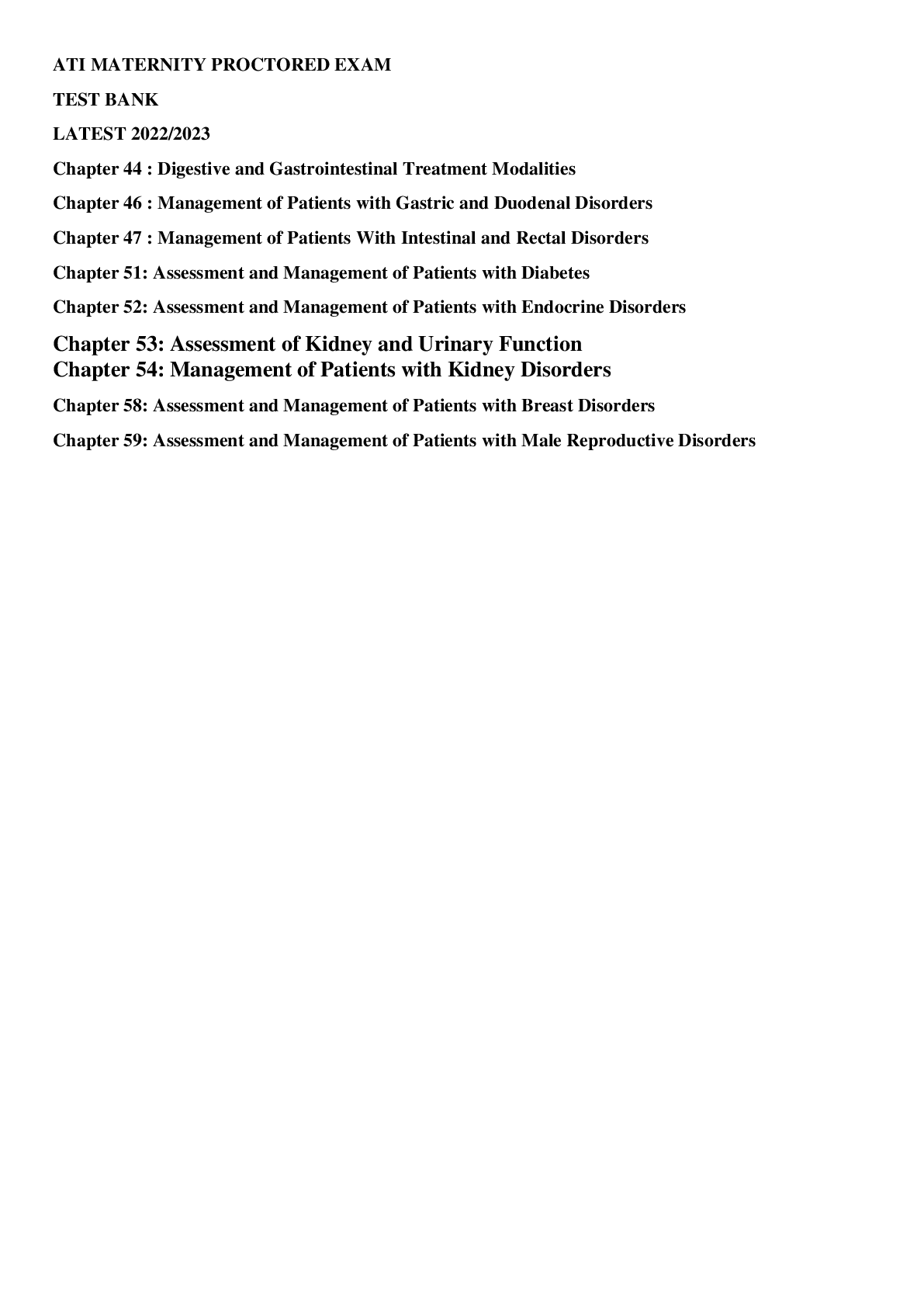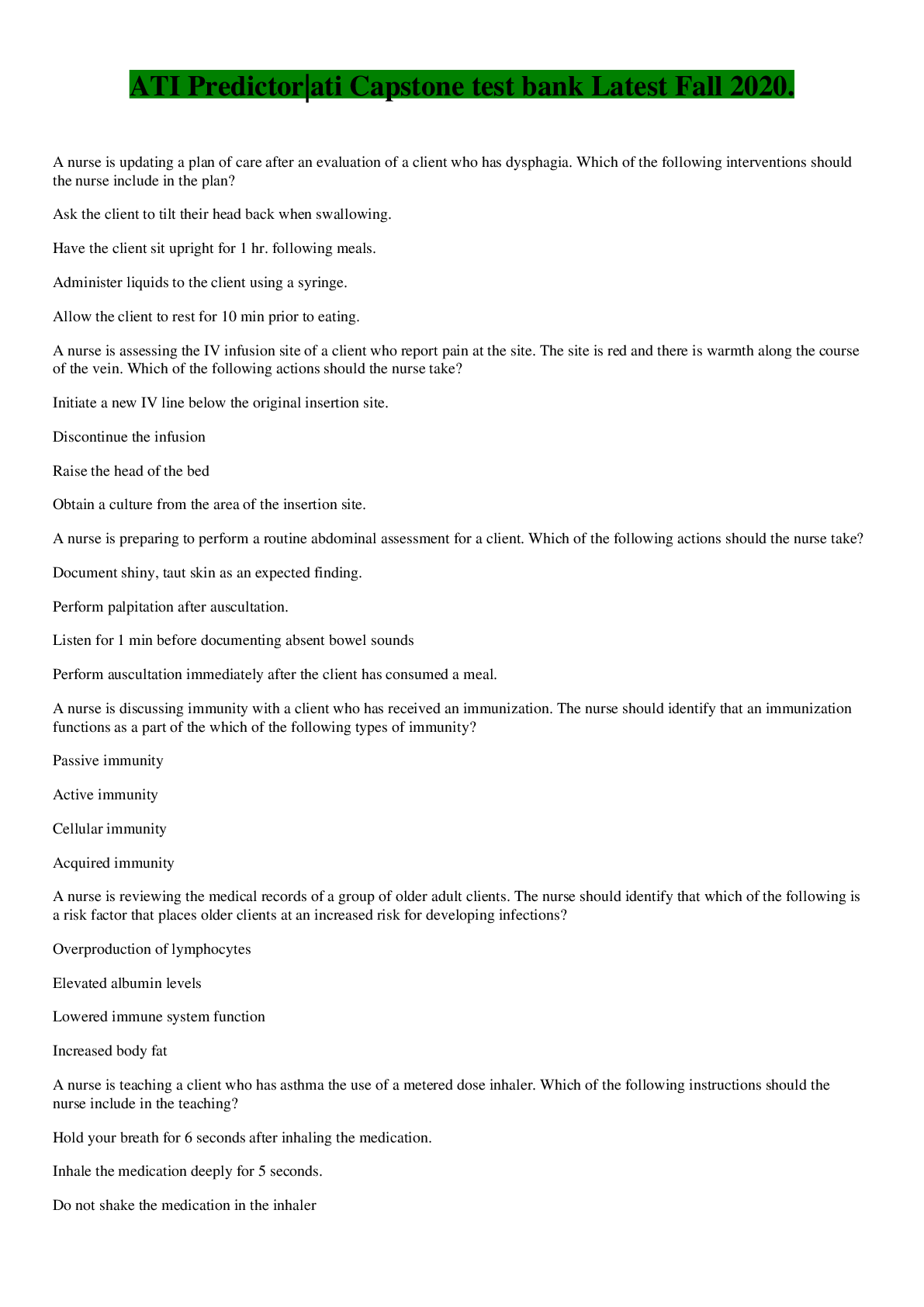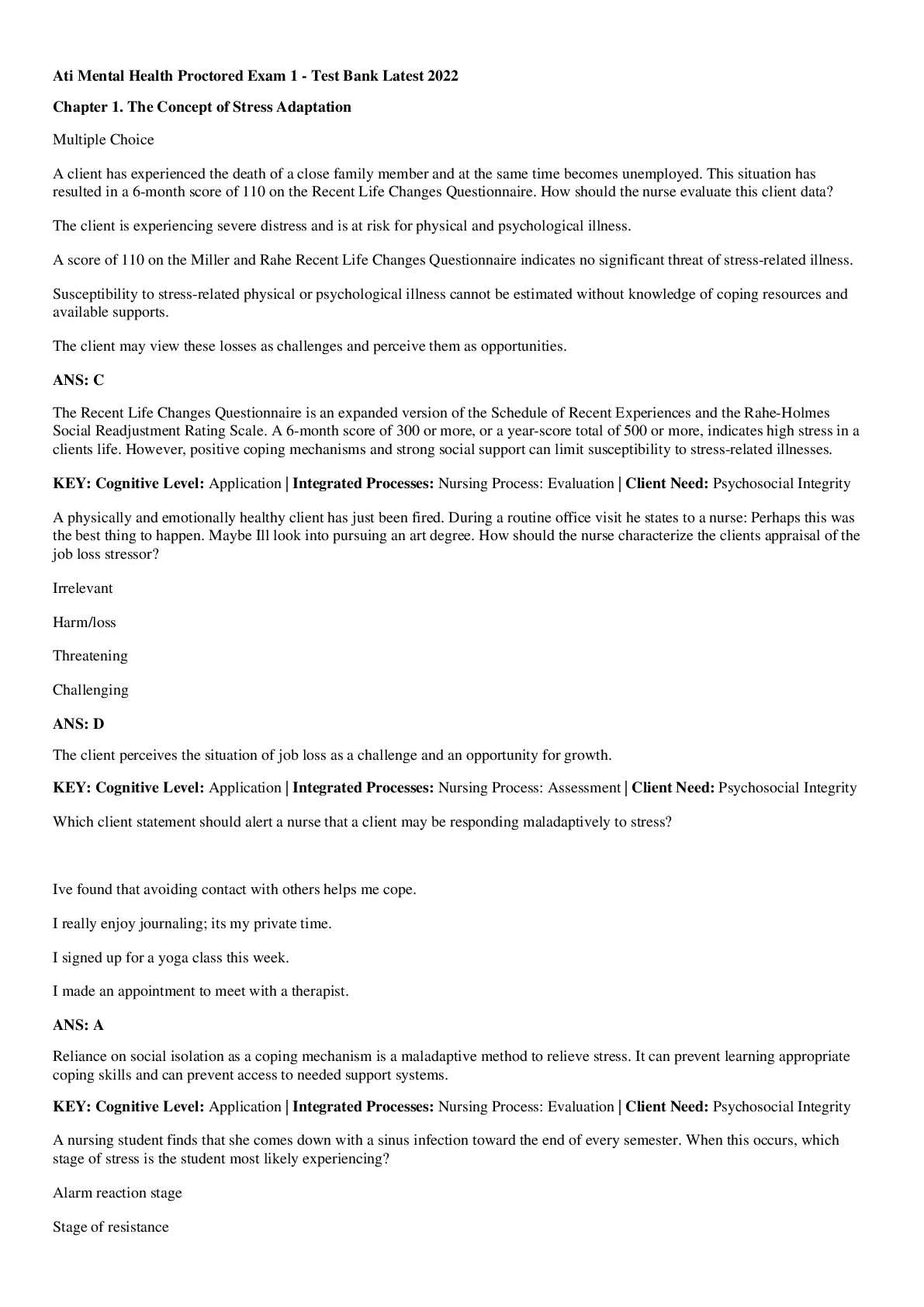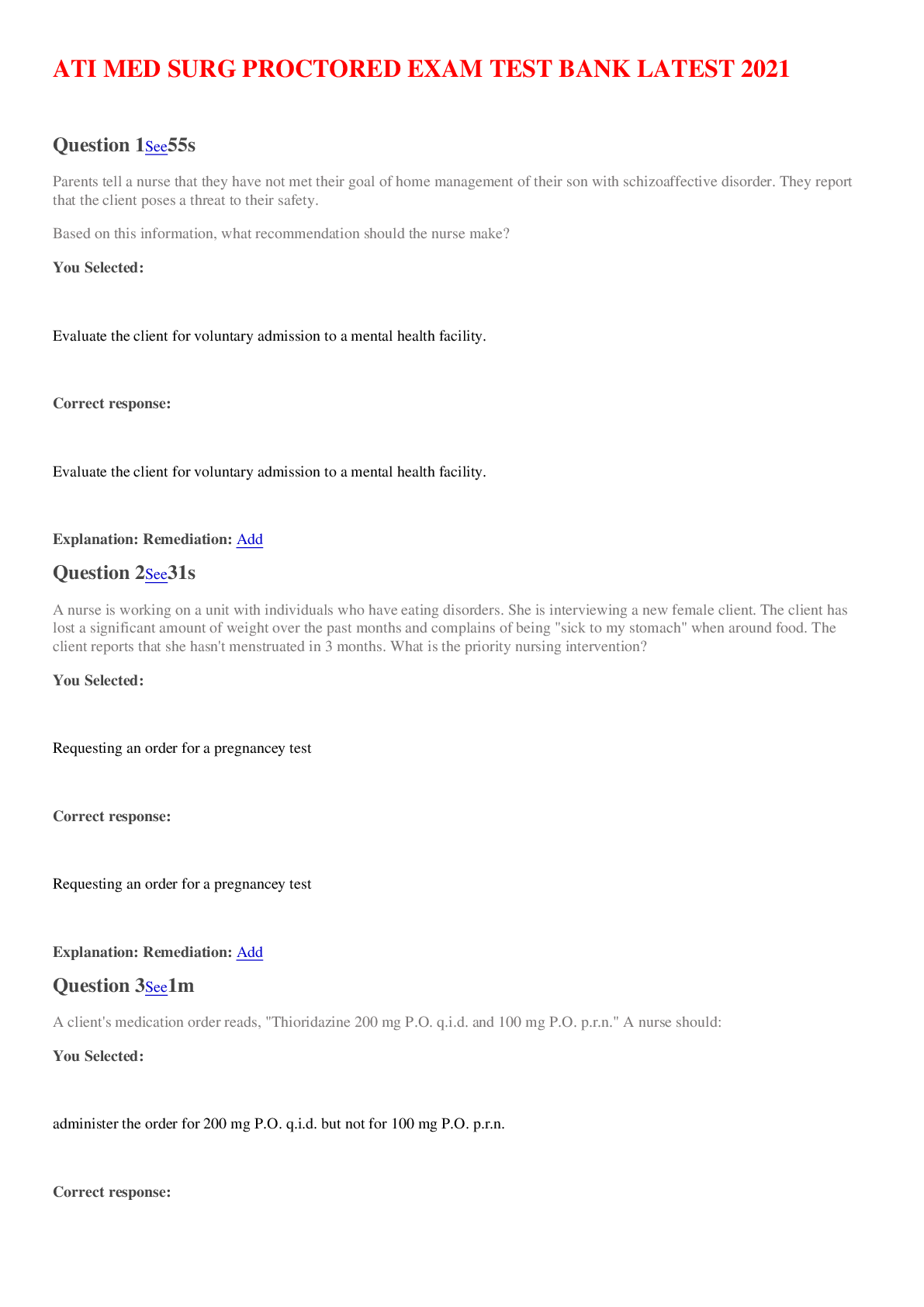*NURSING > STUDY GUIDE > HESI Maternity Test Bank Latest Update Verified Questions & Answers Top Grade (All)
HESI Maternity Test Bank Latest Update Verified Questions & Answers Top Grade
Document Content and Description Below
HESI Maternity Test Bank 2021/2022 The nurse is caring for a pregnant woman who admits to using cocaine and ecstasy on a regular basis. The client states, "Everybody knows that alcohol is bad during ... pregnancy, but what's the big deal about ecstasy?" What is the nurse's best response? 1. "Ecstasy can cause a high fever in you and therefore cause the baby harm." 2. "Ecstasy leads to deficiencies of thiamine and folic acid, which help the baby develop." 3. "Ecstasy produces babies with small heads and short bodies with brain function alterations." 4. "Ecstasy produces intrauterine growth restriction and meconium aspiration." The nurse is doing preconception counseling with a 28-year-old woman with no prior pregnancies. Which statement made by the client indicates to the nurse that the client has understood the teaching? 1. "I can continue to drink alcohol until I am diagnosed as pregnant." 2. "I need to stop drinking alcohol completely when I start trying to get pregnant." 3. "A beer once a week will not damage the fetus." 4. "I can drink alcohol while breastfeeding because it doesn't pass into breast milk." A woman's history and appearance suggest drug abuse. What is the nurse's best approach? 1. Ask the woman directly, "Do you use any street drugs?" 2. Ask the woman whether she would like to talk to a counselor. 3. Ask some questions about over-the-counter medications and avoid mention of illicit drugs. 4. Explain how harmful drugs can be for her baby. A 20-year-old woman is at 28 weeks' gestation. Her prenatal history reveals past drug abuse, and urine screening indicates that she has recently used heroin. The nurse should recognize that the woman is at increased risk for which condition? 1. Erythroblastosis fetalis 2. Diabetes mellitus 3. Abruptio placentae 4. Pregnancy-induced hypertension The nurse is working with a woman who abuses stimulants. The nurse is aware that the fetus is at risk for which of the following? Select all that apply. 1. Withdrawal symptoms 2. Cardiac anomalies 3. Sudden infant death syndrome 4. Being small for gestational age 5. Fetal alcohol syndrome The nurse is assessing a woman at 10 weeks' gestation who is addicted to alcohol. The woman asks the nurse, "What is the point of stopping drinking now if my baby probably has been hurt by it already?" What is the best response by the nurse? 1. "It won't help your baby, but you will feel better during your pregnancy if you stop now." 2. "If you stop now, you and your baby have less chance of serious complications." 3. "If you limit your drinking to once a week, your baby will be okay." 4. "You might as well stop it now, because once your baby is born, you'll have to give up alcohol if you plan on breastfeeding." The client has just been diagnosed as diabetic. The nurse knows teaching was effective when the client makes which statement? 1. "Ketones in my urine mean that my body is using the glucose appropriately." 2. "I should be urinating frequently and in large amounts to get rid of the extra sugar." 3. "My pancreas is making enough insulin, but my body isn't using it correctly." 4. "I might be hungry frequently because the sugar isn't getting into the tissues the way it should." The client with insulin-dependent type 2 diabetes and an HbA1c of 5.0% is planning to become pregnant soon. What anticipatory guidance should the nurse provide this client? 1. Insulin needs decrease in the first trimester and usually begin to rise late in the first trimester as glucose use and glycogen storage by the woman and fetus increase. 2. The risk of ketoacidosis decreases during the length of the pregnancy. 3. Vascular disease that accompanies diabetes slows progression. 4. The baby is likely to have a congenital abnormality because of the diabetes. A newly diagnosed insulin-dependent type 1 diabetic with good blood sugar control is at 20 weeks' gestation. She asks the nurse how her diabetes will affect her baby. What would the best explanation include? 1. "Your baby could be smaller than average at birth." 2. "Your baby will probably be larger than average at birth." 3. "As long as you control your blood sugar, your baby will not be affected at all." 4. "Your baby might have high blood sugar for several days." A 26-year-old client is 28 weeks pregnant. She has developed gestational diabetes. She is following a program of regular exercise, which includes walking, bicycling, and swimming. What instructions should be included in a teaching plan for this client? 1. "Exercise either just before meals or wait until 2 hours after a meal." 2. "Carry hard candy (or other simple sugar) when exercising." 3. "If your blood sugar is 120 mg/dL, eat 20 g of carbohydrate." 4. "If your blood sugar is more than 120 mg/dL, drink a glass of whole milk." A 26-year-old client is 26 weeks pregnant. Her previous births include two large-for-gestational- age babies and one unexplained stillbirth. Which tests would the nurse anticipate as being most definitive in diagnosing gestational diabetes? 1. A 50g, 1-hour glucose screening test 2. A single fasting glucose level 3. A 100g, 1-hour glucose tolerance test 4. A 100g, 3-hour glucose tolerance test A client with diabetes is receiving preconception counseling. The nurse will emphasize that during the first trimester, the woman should be prepared for which of the following? 1. The need for less insulin than she normally uses 2. Blood testing for anemia 3. Assessment for respiratory complications 4. Assessment for contagious conditions The nurse has written the nursing diagnosis Injury, Risk for a diabetic pregnant client. Interventions for this diagnosis include which of the following? Select all that apply. 1. Assessment of fetal heart tones 2. Perform oxytocin challenge test, if ordered 3. Refer the client to a diabetes support group 4. Assist with the biophysical profile assessment 5. Develop an appropriate teaching plan A diabetic client goes into labor at 36 weeks' gestation. Provided that tests for fetal lung maturity are successful, the nurse will anticipate which of the following interventions? Select all that apply. 1. Administration of tocolytic therapy 2. Beta-sympathomimetic administration 3. Allowance of labor to progress 4. Hourly blood glucose monitoring 5. Cesarean birth may be indicated if evidence of reassuring fetal status exists A woman asks her nurse what she can do before she begins trying to get pregnant to help her baby, as she is prone to anemia. What would the nurse correctly advise her to do? 1. Get pregnant, then start iron supplementation. 2. Add more carbohydrates to her diet. 3. Begin taking folic acid supplements daily. 4. Have a hemoglobin baseline done now so her progress can be followed. The client with thalassemia intermedia has a hemoglobin level of 9.0. The nurse is preparing an education session for the client. Which statement should the nurse include? 1. "You need to increase your intake of meat and other iron-rich foods." 2. "Your low hemoglobin could put you into preterm labor." 3. "Increasing your vitamin C intake will help your hemoglobin level." 4. "You should not take iron supplements." The client at 20 weeks' gestation has had an ultrasound that revealed a neural tube defect in her fetus. The client's hemoglobin level is 8.5. The nurse should include which statement when discussing these findings with the client? 1. "Your low iron intake has caused anemia, which leads to the neural tube defect." 2. "You should increase your vitamin C intake to improve your anemia." 3. "You are too picky about food. Your poor diet caused your baby's defect." 4. "You haven't had enough folic acid in your diet. You should take a supplement." The clinic nurse is teaching a pregnant client about her iron supplement. Which information is included in the teaching? Note: Credit will be given only if all correct and no incorrect choices are selected. Select all that apply. 1. Iron does not affect the gastrointestinal tract. 2. A stool softener might be needed. 3. Start a low dose, and increase it gradually. 4. Expect the stools to be black and bloody. 5. Iron absorption is poor if taken with meals. The client at 9 weeks' gestation has been told that her HIV test was positive. The client is very upset, and tells the nurse, "I didn't know I had HIV! What will this do to my baby?" The nurse knows teaching has been effective when the client makes which statement? 1. "I cannot take the medications that control HIV during my pregnancy, because they will harm the baby." 2. "My baby can get HIV during the pregnancy and through my breast milk." 3. "The pregnancy will increase the progression of my disease and will reduce my CD4 counts." 4. "The HIV won't affect my baby, and I will have a low-risk pregnancy without additional testing." During the history, the client admits to being HIV-positive and says she knows that she is about 16 weeks pregnant. Which statements made by the client indicate an understanding of the plan of care both during the pregnancy and postpartally? Select all that apply. 1. "During labor and delivery, I can expect the zidovudine (ZDV) to be given in my IV." 2. "After delivery, the dose of zidovudine (ZDV) will be doubled to prevent further infection." 3. "My baby will be started on zidovudine (ZDV) for six weeks following the birth." 4. "My baby's zidovudine (ZDV) will be given in a cream form." 5. "My baby will not need zidovudine (ZDV) if I take it during my pregnancy." A woman is 32 weeks pregnant. She is HIV-positive but asymptomatic. The nurse knows what would be important in managing her pregnancy and delivery? 1. An amniocentesis at 30 and 36 weeks 2. Weekly non-stress testing beginning at 32 weeks' gestation 3. Application of a fetal scalp electrode as soon as her membranes rupture in labor 4. Administration of intravenous antibiotics during labor and delivery A pregnant woman is married to an intravenous drug user. She had a negative HIV screening test just after missing her first menstrual period. What would indicate that the client needs to be retested for HIV? 1. Hemoglobin of 11 g/dL and a rapid weight gain 2. Elevated blood pressure and ankle edema 3. Shortness of breath and frequent urination 4. Persistent candidiasis The nurse is evaluating the goal "Client will remain free of opportunistic infections" for an HIV- positive pregnant client. The nurse determines the goal was met when the client has which of the following? Select all that apply. 1. An absolute CD4+ T-lymphocyte count below 200 2. No complaint of chills or fever during the pregnancy 3. Weight gain of 30 lbs during the pregnancy 4. ESR above 20 mm/hr 5. Normal erythrocyte sedimentation rate maintained during the pregnancy Women with HIV should be evaluated and treated for other sexually transmitted infections and for what condition occurring more commonly in women with HIV? 1. Syphilis 2. Toxoplasmosis 3. Gonorrhea 4. Herpes A 21-year-old at 12 weeks' gestation with her first baby has known cardiac disease, class III, as a result of childhood rheumatic fever. During a prenatal visit, the nurse reviews the signs of cardiac decompensation with her. The nurse will know that the client understands these signs and symptoms if she states that she would notify her doctor if she had which symptom? 1. "A pulse rate increase of 10 beats per minute" 2. "Breast tenderness" 3. "Mild ankle edema" 4. "A frequent cough" A client is at 12 weeks' gestation with her first baby. She has cardiac disease, class III. She states that she had been taking sodium warfarin (Coumadin), but her physician changed her to heparin. She asks the nurse why this was done. What should the nurse's response be? 1. "Heparin is used when coagulation problems are resolved." 2. "Heparin is safer because it does not cross the placenta." 3. "They are the same drug, but heparin is less expensive." 4. "Coumadin interferes with iron absorption in the intestines." A 21-year-old woman is at 12 weeks' gestation with her first baby. She has cardiac disease, class III, as a result of having had childhood rheumatic fever. Which planned activity would indicate to the nurse that the client needs further teaching? 1. "I will be sure to take a rest period every afternoon." 2. "I would like to take childbirth education classes in my last trimester." 3. "I will have to cancel our trip to Disney World." 4. "I am going to start my classes in water aerobics next week." Which of the following symptoms, if progressive, are indicative of CHF, the heart's signal of its decreased ability to meet the demands of pregnancy? Select all that apply. 1. Palpitations 2. Heart murmurs 3. Dyspnea 4. Frequent urination 5. Rales The nurse is evaluating the plan of care for a pregnant client with a heart disorder. The nurse concludes that the plan was successful when data indicate which of the following? Select all that apply. 1. The client gave birth to a healthy baby. 2. The client did not develop congestive heart failure. 3. The client developed thromboembolism. 4. The client identified manifestations of potential complications. 5. The client can identify her condition and its impact on her pregnancy, labor and birth, and postpartum period. The renatal clinic nurse has received four phone calls. Which client should the nurse call back first 1. Pregnant woman at 28 weeks with history of asthma who is reporting difficulty breathing an shortness of breath 2. Pregnant woman at 6 weeks with a seizure disorder who is inquiring which foods are good folc acid sources for her 3. Pregnant woman at 35 weeks with a positive HBsAG who is wondering what treatment her baby will receive after birth 4. Pregnant woman at 11 weeks with untreated hyperthyroidism who is describing the onset of vaginal bleeding The nurse is working with a pregnant woman who has systemic lupus erythematosus (SLE). What does the nurse anticipate the infant might be born with? Select all that apply. 1. A tendency to bleed excessively 2. An increased chance of developing infections 3. A hemoglobin less than optimal for good health 4. Problems with vision 5. Hearing loss A pregnant asthmatic client is being seen for her initial prenatal visit. The nurse knows that the fetal implications of maternal asthma include which of the following? Select all that apply. 1. Prematurity 2. Low birth weight 3. Hypoxia with maternal exacerbation 4. Congenital anomalies from the medications 5. Perinatal transfer of the asthma While doing a prenatal assessment on a woman who has hepatitis B and intends to become pregnant, the nurse explains the impact of the hepatitis B on pregnancy and birth. Which statement does the nurse include in the teaching? 1. "Your baby contracted hepatitis B from you when she was conceived." 2. "Don't worry about your baby during the birth. You're more likely to be affected then by the hepatitis B." 3. "Your baby will be immune to your hepatitis B." 4. "Hepatitis B does not usually affect the course of pregnancy." The nurse is caring for a client who was just admitted to rule out ectopic pregnancy. Which orders are the most important for the nurse to perform? Select all that apply. 1. Assess the client's temperature. 2. Document the time of the client's last meal. 3. Obtain urine for urinalysis and culture. 4. Report complaints of dizziness or weakness. 5. Have the lab draw blood for B-hCG level every 48 hours. The nurse educator is presenting a class on the different kinds of miscarriages. Miscarriages, or spontaneous abortions, are classified clinically into which of the following different categories? Select all that apply. 1. Threatened bortion 2. Incomplee abortion 3. Complete abortion 4. Missed abortin 5. Acute abortion The nurse is presenting a class on the pathophysiology of the different abortions. Some of the causes are which of the following? Select all that apply. 1. Chromosomal abnormalities 2. Insufficient or excessive hormonal levels 3. Sexual intercourse in the first trimester 4. Infections in the first trimester 5. Cervical insufficiency A woman is hospitalized with severe preeclampsia. The nurse is meal-planning with the client and encourages a diet that is high in what? 1. Sodium 2. Carbohydrates 3. Protein 4. Fruits The nurse is assessing a client who has severe preeclampsia. What assessment finding should be reported to the physician? 1. Excretion of less than 300 mg of protein in a 24-hour period 2. Platelet count of less than 100,000/mm3 3. Urine output of 50 mL per hour 4. 12 respirations A woman is 16 weeks pregnant. She has had cramping, backache, and mild bleeding for the past 3 days. Her physician determines that her cervix is dilated to 2 centimeters, with 10% effacement, but membranes are still intact. She is crying, and says to the nurse, "Is my baby going to be okay?" In addition to acknowledging the client's fear, what should the nurse also say? 1. "Your baby will be fine. We'll start IV, and get this stopped in no time at all." 2. "Your cervix is beginning to dilate. That is a serious sign. We will continue to monitor you and the baby for now." 3. "You are going to miscarry. But you should be relieved because most miscarriages are the result of abnormalities in the fetus." 4. "I really can't say. However, when your physician comes, I'll ask her to talk to you about it." The nurse is supervising care in the emergency department. Which situation most requires an intervention? 1. Moderate vaginal bleeding at 36 weeks' gestation; client has an IV of lactated Ringer's solution running at 125 mL/hour 2. Spotting of pinkish-brown discharge at 6 weeks' gestation and abdominal cramping; ultrasound scheduled in 1 hour 3. Bright red bleeding with clots at 32 weeks' gestation; pulse = 110, blood pressure 90/50, respirations = 20 4. Dark red bleeding at 30 weeks' gestation with normal vital signs; client reports an absence of fetal movement A client who is 11 weeks pregnant presents to the emergency department with complaints of dizziness, lower abdominal pain, and right shoulder pain. Laboratory tests reveal a beta-hCG at a lower-than-expected level for this gestational age. An adnexal mass is palpable. Ultrasound confirms no intrauterine gestation. The client is crying and asks what is happening. The nurse knows that the most likely diagnosis is an ectopic pregnancy. Which statement should the nurse include? 1. "You're feeling dizzy because the pregnancy is compressing your vena cava." 2. "The pain is due to the baby putting pressure on nerves internally." 3. "The baby is in the fallopian tube; the tube has ruptured and is causing bleeding." 4. "This is a minor problem. The doctor will be right back to explain it to you." A client at 18 weeks' gestation has been diagnosed with a hydatidiform mole. In addition to vaginal bleeding, which signs or symptoms would the nurse expect to see? Select all that apply. 1. Hyperemesis gravidarum 2. Diarrhea and hyperthermia 3. Uterine enlargement greater than expected 4. Polydipsia 5. Vaginal bleeding A woman at 7 weeks' gestation is diagnosed with hyperemesis gravidarum. Which nursing diagnosis would receive priority? 1. Fluid Volume: Deficient 2. Cardiac Output, Decreased 3. Injury, Risk for 4. Nutrition, Imbalanced: Less than Body Requirements The prenatal clinic nurse is caring for a client with hyperemesis gravidarum at 14 weeks' gestation. The vital signs are: blood pressure 95/48, pulse 114, respirations 24. Which order should the nurse implement first? 1. Weigh the client. 2. Give 1 liter of lactated Ringer's solution IV. 3. Administer 30 mL Maalox (magnesium hydroxide) orally. 4. Encourage clear liquids orally. A pregnant client has been admitted with a diagnosis of hyperemesis. Which orders written by the primary healthcare provider are the highest priorities for the nurse to implement? Select all that apply. 1. Obtain complete blood count. 2. Start intravenous fluid with multivitamins. 3. Check admission weight. 4. Obtain urine for urinalysis. 5. Give a medication to stop the nausea and vomiting. A primary herpes simplex infection in the first trimester can increase the risk of which of the following? 1. Spontaneous abortion 2. Preterm labor 3. Intrauterine growth restriction 4. Neonatal infection A woman is being treated for preterm labor with magnesium sulfate. The nurse is concerned that the client is experiencing early drug toxicity. What assessment finding by the nurse indicates early magnesium sulfate toxicity? 1. Patellar reflexes weak or absent 2. Increased appetite 3. Respiratory rate of 16 4. Fetal heart rate of 120 Doppler flow studies (umbilical velocimetry) help to assess which of the following? 1. Placental function and sufficiency 2. Fetal heart rate 3. Fetal growth and fluid levels 4. Maturity of the fetal lungs When blood pressure and other signs indicate that the preeclampsia is worsening, hospitalization is necessary to monitor the woman's condition closely. At that time, which of the following should be assessed? Select all that apply. 1. Fetal heart rate 2. Blood pressure 3. Temperature 4. Urine color 5. Pulse and respirations The community nurse is working with a client at 32 weeks' gestation who has been diagnosed with preeclampsia. Which statement by the client would indicate that additional information is needed? 1. "I should call the doctor if I develop a headache or blurred vision." 2. "Lying on my left side as much as possible is good for the baby." 3. "My urine could become darker and smaller in amount each day." 4. "Pain in the top of my abdomen is a sign my condition is worsening." Infants of women with preeclampsia during pregnancy tend to be small for gestational age (SGA) because of which condition? 1. Intrauterine growth restriction 2. Oliguria 3. Proteinuria 4. Hypertension A woman is experiencing preterm labor. The client asks why she is on betamethasone. Which is the nurse's best response? 1. "This medication will halt the labor process until the baby is more mature." 2. "This medication will relax the smooth muscles in the infant's lungs so the baby can breathe." 3. "This medication is effective in stimulating lung development in the preterm infant." 4. "This medication is an antibiotic that will treat your urinary tract infection, which caused preterm labor." A client is being admitted to the labor area with the diagnosis of eclampsia. Which actions by the nurse are appropriate at this time? Select all that apply. 1. Tape a tongue blade to the head of the bed. 2. Pad the side rails. 3. Have the woman sit up. 4. Provide the client with grief counseling. 5. The airway should be maintained and oxygen administered. A clinic nurse is planning when to administer Rh immune globulin (RhoGAM) to an Rh-negative pregnant client. When should the first dose of RhoGAM be administered? 1. After the birth of the infant 2. 1 month postpartum 3. During labor 4. At 28 weeks' gestation Whether sensitization is the result of a blood transfusion or maternal-fetal hemorrhage for any reason, what test can be performed to determine the amount of Rh(D) positive blood present in the maternal circulation and to calculate the amount of Rh immune globulin needed? 1. Indirect Coombs' test 2. Nonstress test 3. Kleihauer-Betke or rosette test 4. Direct Coombs' test Which maternal-child client should the nurse see first? 1. Blood type O, Rh-negative 2. Indirect Coombs' test negative 3. Direct Coombs' test positive 4. Blood type B, Rh-positive The client with blood type A, Rh-negative, delivered yesterday. Her infant is blood type AB, Rh- positive. Which statement indicates that teaching has been effective? 1. "I need to get RhoGAM so I don't have problems with my next pregnancy." 2. "Because my baby is Rh-positive, I don't need RhoGAM." 3. "If my baby had the same blood type I do, it might cause complications." 4. "Before my next pregnancy, I will need to have a RhoGAM shot." A client is concerned because she has been told her blood type and her baby's are incompatible. What is the nurse's best response? 1. "This is called ABO incompatibility. It is somewhat common but rarely causes significant hemolysis." 2. "This is a serious condition, and additional blood studies are currently in process to determine whether you need a medication to prevent it from occurring with a future pregnancy." 3. "This is a condition caused by a blood incompatibility between you and your husband, but does not affect the baby." 4. "This type of condition is very common, and the baby can receive a medication to prevent jaundice from occurring." If the woman is Rh negative and not sensitized, she is given Rh immune globulin to prevent what? 1. The potential for hemorrhage 2. Hyperhomocysteinemia 3. Antibody formation 4. Tubal pregnancy The client presents to the clinic for an initial prenatal examination. She asks the nurse whether there might be a problem for her baby because she has type B Rh-positive blood and her husband has type O Rh-negative blood, or because her sister's baby had ABO incompatibility. What is the nurse's best answer? Select all that apply. 1. "Your baby would be at risk for Rh problems if your husband were Rh-negative." 2. "Rh problems only occur when the mother is Rh-negative and the father is not." 3. "ABO incompatibility occurs only after the baby is born." 4. "We don't know for sure, but we can test for ABO incompatibility." 5. "Your husband's being type B puts you at risk for ABO incompatibility." A woman has a hydatidiform mole (molar pregnancy) evacuated, and is prepared for discharge. The nurse should make certain that the client understands that what is essential? 1. That she not become pregnant until after the follow-up program is completed 2. That she receive RhoGAM with her next pregnancy and birth 3. That she has her blood pressure checked weekly for the next 30 days 4. That she seek genetic counseling with her partner before the next pregnancy A client at 10 weeks' gestation has developed cholecystitis. If surgery is required, what is the safest time during pregnancy? 1. Immediately, before the fetus gets any bigger 2. Early in the second trimester 3. As close to term as possible 4. The risks are too high to do it anytime in pregnancy The nurse is presenting a class to newly pregnant families. What form of trauma will the nurse describe as the leading cause of fetal and maternal death? 1. Falls 2. Domestic violence 3. Gun accidents 4. Motor vehicle accidents During a prenatal exam, a client describes several psychosomatic symptoms and has several vague complaints. What could these behaviors indicate? 1. Abuse 2. Mental illness 3. Depression 4. Nothing, they are normal The nurse is caring for a client at 35 weeks' gestation who has been critically injured in a shooting. Which statement by the paramedics bringing the woman to the hospital would cause the greatest concern? 1. "Blood pressure 110/68, pulse 90." 2. "Entrance wound present below the umbilicus." 3. "Client is positioned in a left lateral tilt." 4. "Clear fluid is leaking from the vagina." The client at 34 weeks' gestation has been stabbed in the low abdomen by her boyfriend. She is brought to the emergency department for treatment. Which statements indicate that the client understands the treatment being administered? Select all that apply. 1. "The baby needs to be monitored to check the heart rate." 2. "My bowel has probably been lacerated by the knife." 3. "I might need an ultrasound to look at the baby." 4. "The catheter in my bladder will prevent urinary complications." 5. "The IV in my arm will replace the amniotic fluid if it is leaking." A client is admitted to the labor suite. It is essential that the nurse assess the woman's status in relation to which infectious diseases? Select all that apply. 1. Chlamydia trachomatis 2. Rubeola 3. Varicella 4. Group B streptococcus 5. Acute pyelonephritis The nurse knows that a mother who has been treated for Beta streptococcus passes this risk on to her newborn. Risk factors for neonatal sepsis caused by Beta streptococcus include which of the following? Select all that apply. 1. Prematurity 2. Maternal intrapartum fever 3. Membranes ruptured for longer than 18 hours 4. A previously infected infant with GBS disease 5. An older mother having her first baby How would the nurse best analyze the results from a client's sonogram that shows the fetal shoulder as the presenting part? 1. Breech, transverse 2. Breech, longitudinal 3. Breech, frank 4. Vertex, transverse A clinic nurse is preparing diagrams of pelvic shapes. Which pelvic shapes are considered least adequate for vaginal childbirth? Select all that apply. 1. Android 2. Anthropoid 3. Gynecoid 4. Platypelloid 5. Lambdoidal suture The nurse is caring for laboring clients. Which women are experiencing problems related to a critical factor of labor? Select all that apply. 1. Woman at 7 cm, fetus in general flexion 2. Woman at 3 cm, fetus in longitudinal lie 3. Woman at 4 cm, fetus with transverse lie 4. Woman at 6 cm, fetus at -2 station, mild contractions 5. Woman at 5 cm, fetal presenting part is right shoulder The charge nurse has received the shift change report. Which client requires immediate intervention? 1. Woman at 6 cm undergoing induction of labor, strong contractions every 3 minutes 2. Woman at 4 cm whose fetus is in a longitudinal lie with a cephalic presentation 3. Woman at 10 cm and fetus at +2 station experiencing a strong expulsion urge 4. Woman at 3 cm screaming in fear because her mother died during childbirth Premonitory signs of labor include which of the following? Select all that apply. 1. Braxton Hicks contractions 2. Cervical softening and effacement 3. Weight gain 4. Rupture of membranes 5. Sudden loss of energy [Show More]
Last updated: 2 years ago
Preview 1 out of 139 pages
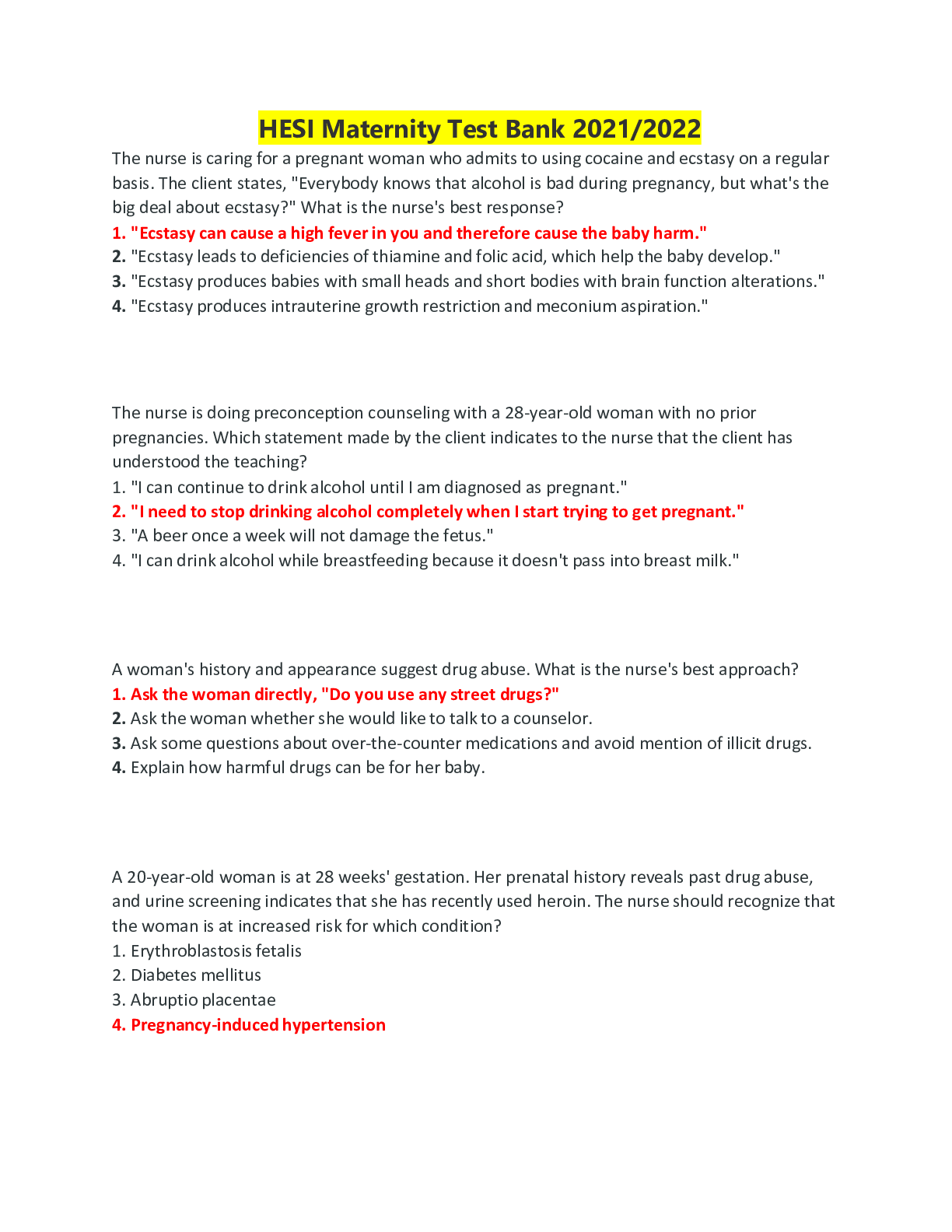
Buy this document to get the full access instantly
Instant Download Access after purchase
Buy NowInstant download
We Accept:

Reviews( 0 )
$15.00
Can't find what you want? Try our AI powered Search
Document information
Connected school, study & course
About the document
Uploaded On
May 04, 2021
Number of pages
139
Written in
Additional information
This document has been written for:
Uploaded
May 04, 2021
Downloads
0
Views
104

